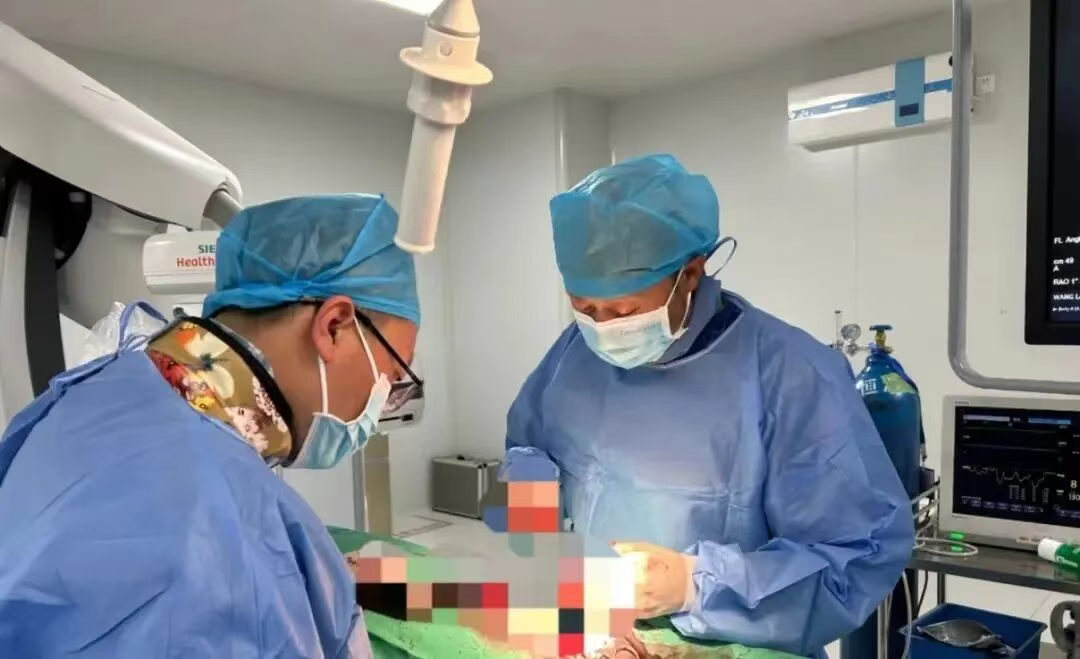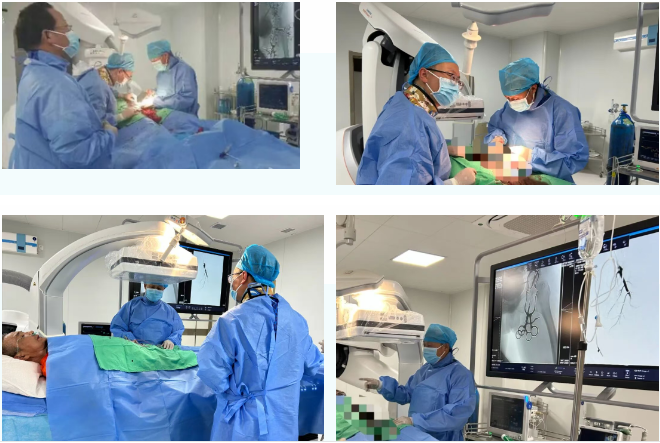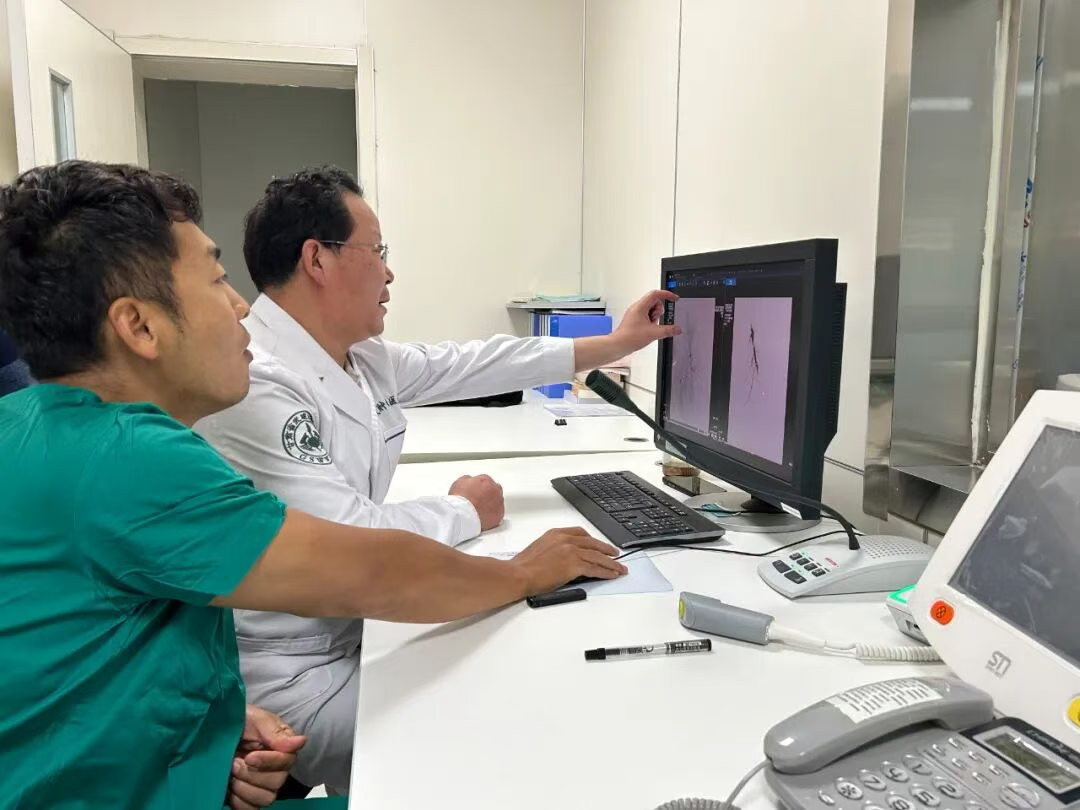Complete Artery Occlusion Faced Amputation, Innovative Technique Skillfully "Saves the Limb"
Complete Artery Occlusion Faced Amputation, Innovative Technique Skillfully "Saves the Limb"
A 54-year-old patient, due to deep femoral artery and popliteal artery thrombosis resulting in complete vascular occlusion, presented with a cold limb and loss of sensation. Wuwei Cancer Hospital of the Medical Sciences employed a new technique – surgical exposure of the blood vessel followed by interventional thrombectomy – successfully saving the leg of a patient who originally faced the risk of amputation.

On October 6th, the hospital's Interventional Department and Department of Orthopedics and Rehabilitation collaborated successfully to perform surgical vascular exposure and interventional thrombectomy on a patient with complete occlusion of the deep femoral and popliteal arteries due to thrombosis. This allowed the patient, who originally faced amputation, to keep his leg.

Mr. Wang, 54 years old, had deep femoral and popliteal artery thrombosis causing complete vascular occlusion, a cold limb, and sensory loss, necessitating amputation. However, to save the limb, the Interventional Department requested a multi-disciplinary consultation to discuss feasible treatment options for limb salvage and thrombectomy.
The hospital's multi-disciplinary team decided on a plan involving surgical exposure of the blood vessels followed by interventional thrombectomy. Finally, on October 6th, the team led by Director Yang Qianzi from the Department of Orthopedics and Rehabilitation completed the vascular exposure in the interventional radiology suite, while the team led by Yang Wangsheng from the Interventional Department performed the thrombectomy. Through this multi-disciplinary collaboration, the patient's treatment was completed successfully: the thrombus was successfully removed, blood flow to the lower limb was restored, and the limb was saved.


Postoperatively, the patient's limb circulation returned to normal, the skin gradually turned rosy, skin temperature recovered, and sensation returned. The patient avoided the risk of amputation and achieved a good outcome.
Deep femoral and popliteal artery thrombosis is a type of lower limb arterial thrombosis. It occurs when blood within the artery changes from liquid to solid due to various reasons, leading to blockage of the lower limb arteries and interruption of blood supply to distal tissues. Clinical manifestations include severe pain in the affected limb, pale skin below the blockage, decreased skin temperature, numbness, and motor dysfunction. If not treated promptly, persistent ischemia can lead to necrosis of the lower limb, resulting in amputation or even life-threatening complications. With the continuous development of interventional techniques and the application of new methods, interventional therapy offers patients minimal trauma, less pain, and significant efficacy, sparing many patients with lower limb arterial thrombosis the suffering of amputation.
How to Prevent Lower Limb Thrombosis
1.Dietary Factors: A high-fat diet is a significant factor in forming atherosclerosis and causing thrombotic diseases. A low-fat diet is recommended.
2.Smoking Factors: Studies indicate that individuals who smoke more than 20 cigarettes per day for over 20 years have a several times higher incidence of thrombotic disease compared to non-smokers of the same age.
3.Pregnancy and Oral Contraceptives: The risk of thrombosis during the postpartum period is six times higher than during the prenatal period. It is advisable to use tubal ligation or contraceptive devices for contraception rather than oral contraceptives, which is particularly important for middle-aged and older women of childbearing age.
4.Obesity Factors: Appropriately increasing physical activity, controlling diet, and reducing weight to lower blood lipids, blood sugar, blood pressure, and blood viscosity are significant for preventing thrombotic diseases.
5.Posture and Activity Factors: Remaining in a single position with little movement for prolonged periods can be a contributing factor to thrombosis. Therefore, it is recommended that individuals who are sedentary or maintain a fixed posture for long periods engage in brief exercise breaks, walks, or limb movements to enhance blood circulation and prevent thrombosis, especially deep vein thrombosis in the lower limbs.
6.Trauma and Surgical Factors: Patients with severe trauma or those who have undergone major surgery are prone to thrombosis or thromboembolism. Therefore, postoperative patients should get out of bed and start moving as early as possible, drink plenty of water, and avoid staying curled up in bed all day. Assist patients with lower limb extension and flexion exercises to improve blood circulation in the feet, toes, and limbs. For patients unable to get out of bed within 24 hours post-surgery, encourage deep breathing to promote blood return; assist the patient in turning over and encourage limb movement in bed; for those with limited mobility, perform passive limb movements or massage the calf muscles to improve lower limb blood flow and prevent thrombotic disease.
Preliminary Review: Zhang Lihong
Final Review: Zhang Jie
